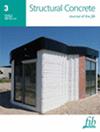The mechanical and microstructural performance of waste textile and cardboard materials in concrete
IF 3
3区 工程技术
Q2 CONSTRUCTION & BUILDING TECHNOLOGY
引用次数: 0
Abstract
Waste fiber reinforced concrete is gaining recognition as a high‐performance construction material, offering notable load‐bearing capacity, corrosion resistance, and enhanced durability features. As the building and construction industry focuses on sustainable practices, fibers derived from waste materials create an opportunity to be utilized further in composite designs. This study explores the tensile, compressive, and flexural behaviors of cardboard fibers (kraft fibers) and textile polyester fibers in concrete materials. The composite microstructure is also investigated using a scanning electron microscope (SEM) to measure the bonding performance of the fibers within the cementitious matrix. Four mix designs were created using 2.5% textile fibers as a reinforcement agent and 5% silica fume modified kraft fibers (SFKFs) as a partial cement replacement. The combination of fibers achieved 44 MPa compressive strength, equaling the control. Tensile strength was enhanced by 5% when using the combination of the two fibers, achieving 3.58 MPa in comparison to 3.41 MPa. However, flexural strength was reduced among all fibrous concrete materials. SEM images distinguished the natural and synthetic characteristics associated with the two fibers within the cementitious matrix. Namely, demonstrating the chemical bonding of SFKFs in comparison with the physical bonding properties of the textile fibers. This study serves as a valuable resource for future investigations and the broader adoption of binary waste fiber composite designs in cementitious composite applications.废纺织品和纸板材料在混凝土中的力学性能和微结构性能
废纤维增强混凝土作为一种高性能建筑材料,在承重能力、耐腐蚀性和增强耐久性等方面都具有显著的优势,正逐渐得到认可。随着建筑行业对可持续发展的重视,从废弃材料中提取的纤维为在复合材料设计中进一步利用创造了机会。本研究探讨了纸板纤维(牛皮纸纤维)和纺织聚酯纤维在混凝土材料中的拉伸、压缩和弯曲行为。此外,还使用扫描电子显微镜(SEM)对复合材料的微观结构进行了研究,以测量纤维在水泥基质中的粘结性能。使用 2.5% 的纺织纤维作为增强剂,5% 的硅灰改性牛皮纸纤维(SFKFs)作为部分水泥替代品,设计了四种混合材料。纤维组合的抗压强度达到 44 兆帕,与对照组相当。两种纤维组合使用时,拉伸强度提高了 5%,达到 3.58 兆帕,而对照组为 3.41 兆帕。然而,所有纤维混凝土材料的抗折强度都有所降低。扫描电子显微镜图像区分了水泥基质中两种纤维的天然和合成特性。也就是说,与纺织纤维的物理粘结性能相比,SFKF 的化学粘结性能更好。这项研究为未来的研究以及在水泥基复合材料应用中更广泛地采用二元废纤维复合材料设计提供了宝贵的资源。
本文章由计算机程序翻译,如有差异,请以英文原文为准。
求助全文
约1分钟内获得全文
求助全文
来源期刊

Structural Concrete
CONSTRUCTION & BUILDING TECHNOLOGY-ENGINEERING, CIVIL
CiteScore
5.60
自引率
15.60%
发文量
284
审稿时长
3 months
期刊介绍:
Structural Concrete, the official journal of the fib, provides conceptual and procedural guidance in the field of concrete construction, and features peer-reviewed papers, keynote research and industry news covering all aspects of the design, construction, performance in service and demolition of concrete structures.
Main topics:
design, construction, performance in service, conservation (assessment, maintenance, strengthening) and demolition of concrete structures
research about the behaviour of concrete structures
development of design methods
fib Model Code
sustainability of concrete structures.
 求助内容:
求助内容: 应助结果提醒方式:
应助结果提醒方式:


